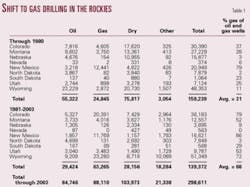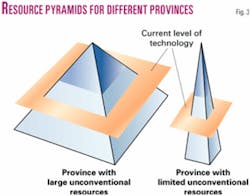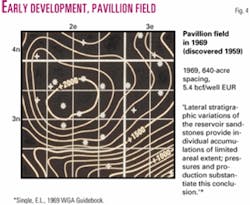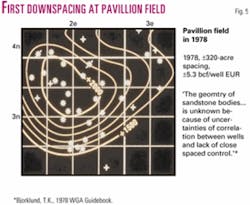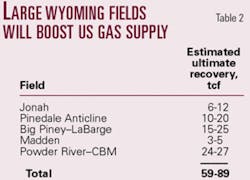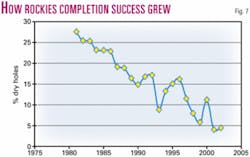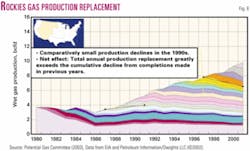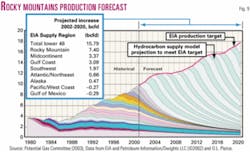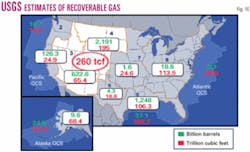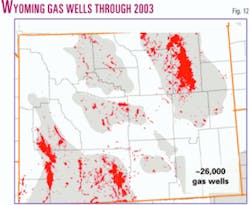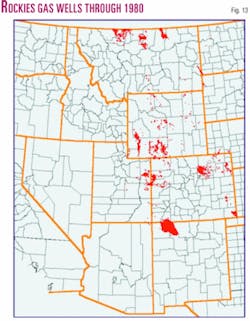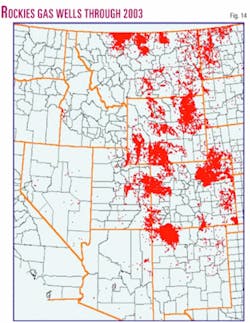The last 20 years of the Rocky Mountains oil and gas exploration and production business have been tumultuous.
Not only have there been major changes in the size and names of the companies doing the exploration, there have been changes in:
- The recognition of the character of reservoirs and traps.
- The technological methodology used in both exploration and development.
Most of the major companies have left; they have been replaced with independents and small to larger private and public companies.
Natural gas has become the primary focus of exploration.
Increased use of seismic, especially 3D seismic, has reduced exploration and development risks, and new drilling and completion techniques have greatly improved recovery and economics.
The Rockies are now an important domestic source of gas yet remain underexplored and underexploited. The area thus has the potential to provide an increasing share of current and future US gas supply.
Shift to gas
In 1980, 22 major oil and gas companies dominated exploration and production.
Additionally, Rocky Mountain basins were viewed as primarily an oil province. Exploration focused on conventional traps and reservoirs in Paleozoic and Mesozoic targets. Major oil company research laboratories dominated the development of technology for exploration and production.
In 2004, 22 major oil and gas companies are merged to eight. These majors have consolidated their exploratory efforts primarily outside of the Rockies by shifting their focus to international opportunities and the Gulf of Mexico while abandoning E&P efforts in the Rockies.
Today the Rockies are predominately a gas province with unconventional Mesozoic and Tertiary reservoirs and traps.
The majors underestimated the gas potential of the Rockies. Independents and small private and public companies have capitalized on this opportunity, with some of them becoming substantially larger companies in the process.
This group of companies, together with service companies, has developed the capabilities to explore for, drill, and complete unconventional Cretaceous and Tertiary coalbed methane deposits, tight gas sands, and gas bearing fractured shales.
The shift of interest from drilling for oil to an emphasis on gas exploration and development in the Rockies since 1980 is easily seen (Fig. 1). During the early 1980s, about twice as many oil wells were drilled than gas wells. In the last 5 years, 10 times as many gas wells were drilled than oil wells.
The Fig. 1 inset reflects the same data in terms of the percentage of gas wells drilled.
Table 1 illustrates this trend on a state-by-state basis through 1980 and for the interval 1981-2003. Through 1980, about twice (2.2 times) as many oil wells were drilled as gas wells. In contrast, a tremendous reversal of emphasis took place in 1981-2003 whereby the averages changed to twice as many (2.15 times) gas wells drilled than oil wells.
It also becomes clear that Wyoming has become the most significant gas producer of the Rockies. Through 1980, 2,900 gas wells were completed in Wyoming. In the succeeding 23 years, between 1981-2003, an additional 23,000 gas wells were completed, or about one-third of all gas producers in the Rockies.
The resource pyramid
Previous authors1 2 have advanced the idea of a resource pyramid to show relative volumes of reserves, resources, and undiscovered gas (Fig. 2).
The pyramid apex represents easily discovered and produced gas.
As exploration, drilling, and completion technology continue to improve, industry is able to exploit an increased volume from the more difficult to extract, leaner resources represented by the lower portion of the pyramid.
Resource pyramids for two hypothetical provinces are diagrammatically shown in Fig. 3. The smaller, proportionally taller pyramid on the right of Fig. 3 represents more conventional reservoirs.
The broader-based pyramid, on the left of Fig. 3, illustrates the gas potential in the Rockies. It shows the proportionally larger resources that are available in less rich reservoirs including coalbed methane, tight gas sands, and fractured shale gas.
The plane that cuts through the pyramid represents the current level of technology in exploiting the resource pyramid. As technology improves, industry is able to extract significantly larger volumes.
We have gone through a difficult geological learning curve that has stimulated the development of drilling and completion technology. Today's technological learning curve remains steep, and even though production is at an all-time high, we continually add to the Rockies reserve base because of technological advances.
Figs. 4, 5, and 63 illustrate a case study in the Rockies that helped change the way we think about certain sandstone reservoirs and traps.
null
null
null
Shell Oil Co. discovered Pavillion field in the northwest Wind River basin in 1960. By 1969, Pavillion had been developed on 640-acre spacing, and decline curves indicated an average estimated ultimate recovery (EUR) of 5.4 bcf/well.
Fig. 5 shows that by 1978, the field had been downspaced to 320 acres and the EUR was 5.3 bcf/well. By 1989, wells drilled on 160-acre spacing had EURs of 5 bcf/well. The fact that such downspacing resulted in similar EURs per well revealed that reservoirs are more complex and compartmentalized than previously thought.
A similar history is seen in the development of Jonah field in the Green River basin, where well spacing has gone from 160 acres to 40 acres (with a 20 acre pilot and study of 10 acres and 5 acres), and the field ultimate has gone from 6 tcf of gas4 to 6-12 tcf (Table 2).
Similarly, well density in some Piceance basin fields is now at 10 acres where it was originally at 640 acres.5 Similar examples of downspacing in development throughout the Rocky Mountain Province are available.
The lesson is that a better understanding of stratigraphy, depositional deposits, and reservoir compartmentalization has led to reduced well spacing. Peter Dea of Western Gas Resources (verbal communication) estimated in 2002 that 30-35 tcf of gas had been added in the Rockies in the last 10 years.6 Much of this reserve addition has been the result of downspacing in known fields.
Government, industry views
As US gas demand grows, a considerable amount of public discussion has centered on public land access concerns and the need to have an intelligent balance in land use.
Wyoming is the only state to have increased gas production every year for the past 18 years and represents an appropriate model for land use in the Rocky Mountain region. Table 2 shows that Wyoming has a number of developing gas fields that have large field EURs which will positively impact the national gas supply.
Additionally, Wyoming is considered to have large underexplored and underexploited resources in tight gas sands, coalbed methane, and deep structural plays and trends. In addition, future technological advances, including geological, geophysical, and operational, should further enhance recoveries from already known conventional and unconventional fields, not just in Wyoming but throughout the Rockies.
Fig. 7 illustrates a dramatic increase in well completion success in the Rockies. Low risk, shallow coalbed methane development has greatly added to the reserve base and success rate. Because of such unconventional plays, Rocky Mountain exploration and development success rates have increased to more than 95% from 72% in the past 20 years.
Recent estimates by the US Energy Information Administration indicate that for the last 15 years the Rockies have consistently increased production (Fig. 8). The Rocky Mountain Province is one of only three US historical gas-producing provinces to have shown an increase and has done so at a rate of six times that of any other.
Fig. 9 shows EIA's gas production target for the Rockies. About half of the increased production to meet US gas demand by the year 2020 must come from the Rockies. This would be an increase in production of 7.4 bcfd over current levels.
Fig. 10 shows the US Geological Survey estimate of 260 tcf recoverable as the remaining economic resource base in the Rocky Mountains. The authors feel this is a realistic estimate because the Rockies have a vast volume of rich mature source rocks and coals plus very thick sections of potential reservoir rocks. The volume of the resource pyramid below the current position of the technology plane represents the very large Rocky Mountain gas potential.
The paucity of seismic coverage in the Rockies, especially the lack of 3D seismic coverage, is evidence of the relatively modest level of exploration in the Rockies. Coverage with 3D seismic is:
- 100% in the Gulf of Mexico;
- 70% on the Gulf Coast;
- 50% in the Permian Basin;
- 20% in Oklahoma; and
- 5-10% of the total potential prospective area in the Rockies.7
An interesting comparison is the total number of gas wells (2,900) in Wyoming through 1980 versus the total number of Wyoming gas wells through 2003 (26,000), or nearly a ten-fold increase (Figs. 11 and 12).
Similarly, the entire Rocky Mountain Province had only 14,000 gas wells with greater than 0.1 bcf EUR through 1980 (Fig. 13), while 83,000 total gas wells through 2002 in the same area had EURs of at least 0.1 bcf (Fig. 14).
The future
In order for industry to meet the supply projections for the Rocky Mountain basins, several things need to happen.
- Greater land accessibility, including a speed-up of the permitting process by the Bureau of Land Management (BLM).l
- More risk takers to invest in new exploration concepts and the financial resources to exploit them.
- Greater investment in infrastructure to deliver natural gas to market so that it will command a nationally competitive price.
We are optimistic that the elements listed above will occur and that the Rocky Mountain Gas Province will meet the industry's expectations and US natural gas energy needs.
References
- Modified from Kuuskraa, V.A., "Emerging gas resources and technology," in RMAG-PTTC-GRI , Future of Coal Bed Methane in the Rocky Mountain Region Symposium, 1999, 9 p.
- Kuuskraa, V.A., and Schmoker, J.W., "Diverse gas plays lurk in gas resource pyramid," OGJ, June 8, 1998, pp. 123-130.
- McPeek, L.A., Newman, G.E., and Thomasson, M.R., "Cave Gulch, Wind River Basin, Wyoming, The Story of a Giant Gas Discovery," in the official program and abstracts, AAPG annual convention, Salt Lake City, 1998. Modified from: Single, E.L., "Pavillion Field, Fremont County Wyoming," in Barlow, J.A., ed., Wyoming Geological Association 21st Field Conference Guidebook, Symposium on Tertiary Rocks of Wyoming, 1969, pp. 101-110; Bjorklund, T.K., "Pavillion Gas Field," in Boyd, R.G., ed., Wyoming Geological Association 30th Field Conference Guidebook, Resources of the Wind River Basin, Casper, Wyo., September 1978, pp. 255-260; Mueller, C., "Pavillion Field," in Oil and Gas Field Symposium Committee, Wyoming Geological Association, Wyoming Oil and Gas Fields Symposium Bighorn and Wind River Basins, 1989, pp. 356-358.
- Meissner, F.F., and Thomasson, M.R., "Exploration opportunities in the Greater Rocky Mountain Region, U.S.A.," in Downey, M.W., Threet, J.C., and Morgan, W.A., eds., "Petroleum provinces of the 21st century," AAPG Memoir 74, 2001, pp. 201-240.
- Steve Cumella, Williams Energy, personal communication Mar. 2, 2004. Williams Energy currently has 29,000 acres approved for 10-acre density drilling within existing well-spacing permits.
- Peter Dea, Western Gas Resources, personal communication.
- Statistics courtesy of Tricia Dark, Terra Ventures ([email protected]).
The authors
M. Ray Thomasson ([email protected]) formed Thomasson Partner Associates Inc. in 1990. Before that he held numerous managerial jobs with Shell in New York, Houston, and London. He was the first chairman of the board of trustees of the American Geological Institute Foundation and an AAPG distinguished lecturer. He was president of AAPG in 1999-2000 and president of AGI in 2003. He has a master's from the University of Wisconsin and a doctors' degree from the University of Missouri.
Paul E. Belanger is a geologist working the Rockies for the past 21/2 years. Before joining Thomasson in 2001, he was employed by ARCO and Amoco, working in various worldwide oil and gas exploration projects. He also served on the Joides Resolution drill ship on Ocean Drilling Program Leg 161. He received a BS in geology from the University of Washington and MS and PhD degrees from Brown University.
Lance Cook is Wyoming State Geologist and director of the Wyoming Geological Survey and lives in Laramie, Wyo. Before joining the Wyoming survey in 1999, he was employed by Union Pacific Resources and Shell Oil Co. working on North American exploration and development projects. He received a BS in geology from Texas Christian University and an MS in geology from the University of New Mexico in 1979.


